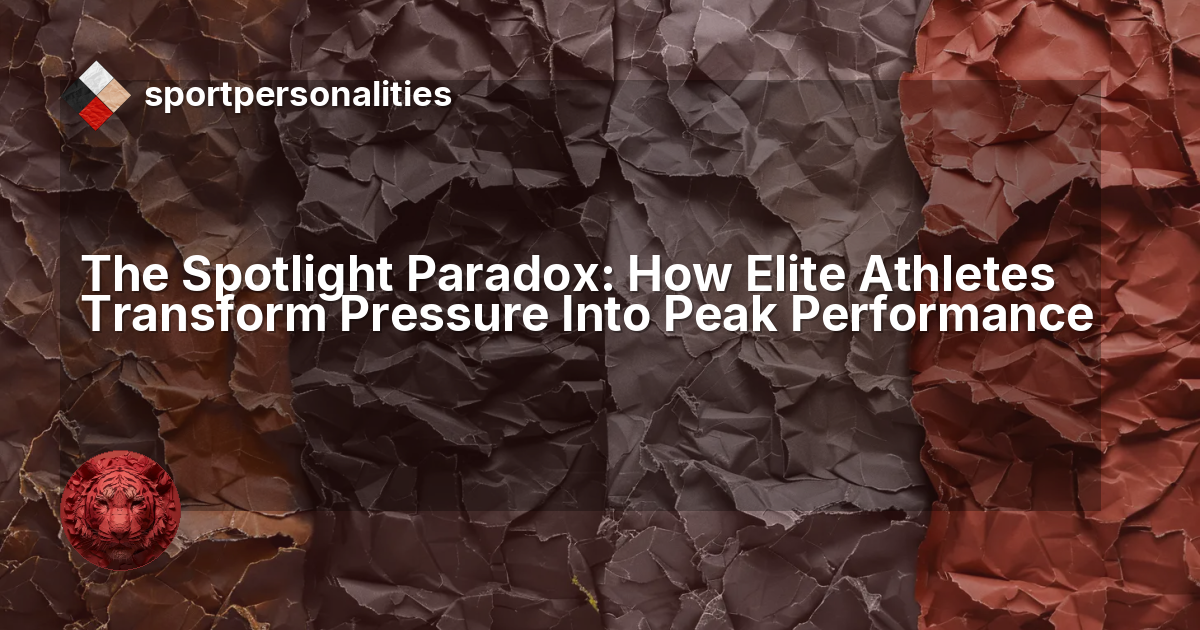The stadium lights burn bright, the cameras zoom in, and suddenly every breath, every movement, every decision becomes magnified. For elite athletes, pressure isn't optional. It's the currency of championship moments.
But here's where it gets interesting: some athletes crumble under the weight of expectation, while others seem to grow stronger as the stakes rise. The difference often comes down to how they approach one fundamental question: When all eyes are on you, do you feed off the energy or try to block it out?
This choice shapes everything from pre-competition routines to in-the-moment decision making. And for athletes who naturally thrive in the spotlight, understanding both sides of this equation can mean the difference between good performances and legendary ones.
Path A: The Energy Amplifier Approach
Some athletes treat pressure like rocket fuel. They actively seek out the crowd's energy, the weight of expectations, and the intensity of the moment. Instead of trying to calm their nervous system, they lean into the activation.
Picture a basketball player stepping up to the free-throw line with the game on the line. Rather than using breathing techniques to slow their heart rate, they take a moment to really hear the crowd. They let the noise wash over them, feel the electricity in the arena, and use that energy to sharpen their focus.
This approach works by transforming nervous energy into performance energy. The athlete doesn't fight their body's natural stress response. Instead, they reframe it. That elevated heart rate becomes readiness. The butterflies become excitement. The weight of the moment becomes fuel for greatness.
Athletes who master this path often develop rituals that help them tap into external energy sources. A soccer player might make eye contact with supporters during warm-ups. A tennis player might acknowledge the crowd after big points, using their reaction to build momentum.
The science backs this up too. When athletes reinterpret their physiological arousal as excitement rather than anxiety, they often perform better. Their bodies are already prepared for peak performance. They just need their minds to get on board.
But this path requires a specific skill set. Athletes need to learn how to ride the wave without being swept away by it. They must develop the ability to channel intensity without letting it scatter their focus or compromise their technique.
Path B: The Inner Sanctuary Approach
The alternative path involves creating an internal bubble of calm amid the chaos. Athletes using this approach develop techniques to minimize external distractions and maintain consistent emotional states regardless of the situation's magnitude.
Consider a golfer facing a crucial putt with thousands watching and millions more on television. Instead of acknowledging the crowd or the stakes, they go through an identical pre-shot routine they've performed thousands of times. They focus on their breathing, visualize the ball's path, and create a mental space where only they and the target exist.
This approach recognizes that peak performance often requires a specific mental state. Too much activation can lead to muscle tension, rushed decisions, and technique breakdown. By controlling their internal environment, athletes can access their optimal performance zone more reliably.
Many athletes in precision sports gravitate toward this path. Gymnasts performing complex routines need consistent focus. Swimmers rely on technical efficiency that can be disrupted by overthinking. Free-throw shooters know that their muscle memory works best when their conscious mind stays quiet.
The key tools here include controlled breathing, visualization, and what psychologists call "attentional narrowing." Athletes learn to systematically reduce their focus until only the most relevant performance cues remain. The crowd noise fades. The cameras disappear. Even their own thoughts about winning and losing get pushed aside.
This path also emphasizes preparation consistency. If an athlete can create the same mental state in practice that they access in competition, the pressure becomes irrelevant. Their performance becomes independent of external circumstances.
 The Superstar (EORC)'s Natural Bias (And Their Blind Spot)
The Superstar (EORC)'s Natural Bias (And Their Blind Spot)
The Superstar naturally gravitates toward the Energy Amplifier approach. Their entire competitive identity revolves around transforming high-stakes moments into stages for extraordinary performance. They don't just tolerate pressure; they crave it.
This makes perfect sense when you understand their core psychology. The Superstar's motivation comes from recognition and glory. The bigger the moment, the brighter the lights, the more intense the scrutiny, the more opportunities they have to showcase their talents. They've learned that their best performances often come when everything is on the line.
Watch them in clutch moments and you'll see this pattern. They tend to become more animated as pressure increases, not less. Their body language projects confidence. They make eye contact with teammates, acknowledge the crowd, and seem to grow larger as the stakes rise. This isn't showboating; it's how they access their peak performance state.
Their reactive nature also supports this bias. The Superstar excels at reading the room, sensing momentum shifts, and responding spontaneously to whatever the moment demands. All of this requires staying connected to external energy rather than retreating into internal focus.
But here lies their potential blind spot. The Superstar's reliance on external energy can become a vulnerability when that energy isn't available or turns negative. What happens during away games with hostile crowds? How do they perform when expectations are low? Can they still access excellence when the spotlight dims?
Their reactive brilliance, while often spectacular, can also lead to inconsistency. If they haven't developed internal regulation skills, they might struggle when the external energy doesn't match their needs. A quiet crowd might leave them feeling flat. Excessive pressure might push them past their optimal activation level.
Discover Your Sport Personality
This article explores one of 16 profiles. Find out which one you are and unlock a personalized blueprint for your athletic journey.
Take the Free TestA Framework for Choice: When to Flex Your Style
The most successful athletes develop the ability to read situations and choose their approach strategically. They understand that different moments call for different mental strategies, even if they have a natural preference.
The key is recognizing three critical factors: the nature of the skill being performed, the type of pressure being faced, and their current emotional state.
For skills requiring explosive power or creative decision-making, the Energy Amplifier approach often works better. When a volleyball player needs to spike with maximum force or a quarterback must improvise under pressure, that activated nervous system becomes an asset. The heightened awareness and increased muscle activation can enhance performance.
But for skills requiring fine motor control or consistent technique, the Inner Sanctuary approach might be more effective. Even a naturally energetic athlete might benefit from creating calm focus when attempting a difficult gymnastics routine or a precision golf shot.
The type of pressure matters too. Positive pressure from supportive crowds might call for one approach, while negative pressure from hostile environments might require another. Time pressure often benefits from the heightened alertness of the Energy Amplifier, while outcome pressure might be better managed through internal focus.
Finally, athletes need to honestly assess their current state. If they're already highly activated, adding more external energy might push them past their optimal zone. If they're feeling flat or disconnected, tapping into crowd energy might provide the spark they need.
The framework becomes: assess the skill demands, read the pressure type, check your current state, then choose your approach. This kind of strategic flexibility allows athletes to maintain their natural strengths while developing complementary skills for different situations.
Training both approaches requires specific practice. Athletes can work on energy amplification techniques during high-intensity scrimmages, learning to channel crowd noise and competitive intensity. They can also practice internal regulation during pressure simulations, developing the ability to create calm focus when needed.
Conclusion: The Strategically Ambidextrous Athlete
The most resilient competitors understand that managing pressure isn't about choosing one approach and sticking with it forever. It's about developing a toolkit that matches the demands of different moments.
The Superstar's natural ability to transform pressure into performance gives them a significant advantage in clutch situations. Their charisma and reactive brilliance often produce the kinds of moments that define careers and create lasting legacies. But by also developing internal regulation skills, they become less dependent on external circumstances for peak performance.
This isn't about changing their fundamental nature. The Superstar will always be drawn to the spotlight, always motivated by recognition and achievement. The goal is expanding their range of responses so they can access excellence across a wider variety of conditions.
When they master both approaches, something powerful happens. They become the athlete who can electrify a home crowd and silence a hostile one. They can deliver spectacular performances when the world is watching and maintain consistent excellence when the stakes seem lower.
The spotlight will always find great athletes. The question is whether they'll be ready to transform whatever pressure it brings into their next great performance.
This content is for educational purposes, drawing on sport psychology research and professional experience. I hold an M.A. in Social Psychology, an ISSA Elite Trainer and Nutrition certification, and completed professional training in Sport Psychology for Athlete Development through the Barcelona Innovation Hub. I am not a licensed clinical psychologist or medical doctor. Individual results may vary. For clinical or medical concerns, please consult a licensed healthcare professional.




